So much for sitting at leisure outside the Urban Room.
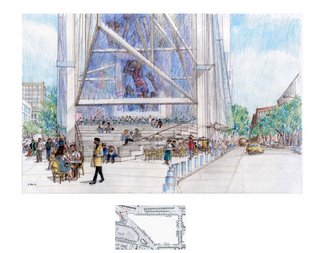 The Urban Room proposed for the corner of Flatbush and Atlantic avenues would serve as the entrance to the Brooklyn Arena and Frank Gehry’s flagship skyscraper Miss Brooklyn. Graphics (right) from landscape architect Laurie Olin show people sitting on the steps and at tables outside.
The Urban Room proposed for the corner of Flatbush and Atlantic avenues would serve as the entrance to the Brooklyn Arena and Frank Gehry’s flagship skyscraper Miss Brooklyn. Graphics (right) from landscape architect Laurie Olin show people sitting on the steps and at tables outside.
(That table in the foreground would be right near a supremely busy intersection.)
Gehry calls it the “front stoop,” a place for kids to "hang out," according to a 5/13/06 Brooklyn Papers article headlined MEET MISS BROOKLYN.
But a newly released “pedestrian wind impact study,” cited in the Atlantic Yards Final Environmental Impact Statement (FEIS), suggests that the area around the Urban Room wouldn’t be suitable for leisure sitting/dining and even some short-term sitting. That suggests that Olin’s illustration is rather fanciful.
(The report is not attached to the FEIS; I asked the Empire State Development Corporation about it, and was forwarded a copy: 2MB PDF and embedded below.)
No significant hardship
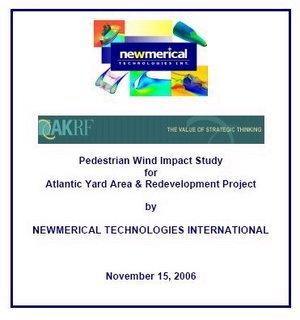 The conclusion to the 22-page report, conducted by Minneapolis-based Newmerical Technologies International for AKRF, the consultancy that conducted most of the environmental impact analysis, is benign:
The conclusion to the 22-page report, conducted by Minneapolis-based Newmerical Technologies International for AKRF, the consultancy that conducted most of the environmental impact analysis, is benign:
In general, while ground-level wind speeds in the area are projected to increase with the addition of the proposed Atlantic Yards Arena project for all locations identified, these increases would not cause significant hardship to pedestrians.
However, data for some specific locations does raise concerns, notably for the uses projected outside the Urban Room. Surveying the location described as “Flatbush Avenue, Arena,” the report states:
All receptor locations indicate wind speeds less than 16 MPH for an 80% recurrence level. These wind levels indicate comfort conditions suitable for walking and general activities.
But not sitting, as in the illustration.
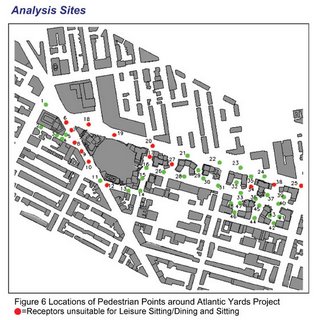 Emerging standards
Emerging standards
New York City, the study acknowledges, does not have wind-related pedestrian comfort criteria, so Newmerical uses general design guidelines used throughout the U.S. and Canada, which define wind speeds determined to be comfortable for different expected uses at least 80% of the time.
In other words, if the wind speeds are not comfortable 80 percent of the time, they’re unacceptable.
At 14 of 48 locations tested (or 29 percent), the results were unacceptable for the two sets of activities most affected by wind. (Those locations are marked in red in the chart at right adapted from Newmerical’s report. Click to enlarge.)
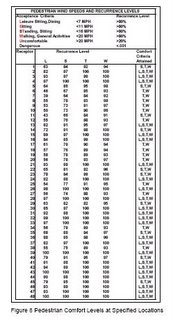 Only wind speeds below 7 MPH are be acceptable for extended leisure sitting or outdoor dining. Only wind speeds below 11 MPH are suitable for “short-term sitting at outdoor cafes, standing, or strolling.” The latter are “light to gentle breezes.”
Only wind speeds below 7 MPH are be acceptable for extended leisure sitting or outdoor dining. Only wind speeds below 11 MPH are suitable for “short-term sitting at outdoor cafes, standing, or strolling.” The latter are “light to gentle breezes.”
Notably, at receptors 6 and 7, at the corner of Atlantic and Flatbush, the results were well below the 80 percent goal.
For receptor 6, the wind would be acceptable for leisure sitting 46 percent of the time; for receptor 7, it would be 39 percent of the time. As for general sitting, the numbers are 67 percent and 64 percent respectively.
However, the report aggregates some numbers and thus obscures the impact on the Urban Room:
With the exception of several locations near the intersection of Flatbush and Atlantic Avenues and a few narrow passages between the proposed buildings, all locations had predicted wind speeds suitable for short term sitting, leisurely walking, and waiting, such as bus stops (<16 mph) ranging from 92% to 100% of the time; near the intersection of Flatbush and Atlantic Avenues and within some narrow passages mentioned above such conditions would be expected at least 84% of the time.
Setting out the problem
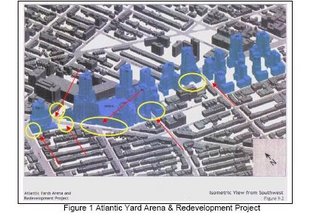 Everyone knows that tall buildings can exacerbate wind. The Williamsburgh Savings Bank tower just northwest of the proposed Atlantic Yards site is a prime example.
Everyone knows that tall buildings can exacerbate wind. The Williamsburgh Savings Bank tower just northwest of the proposed Atlantic Yards site is a prime example.
The report acknowledges:
Large buildings can impact wind speed and turbulence by diverting stronger winds from aloft down to street-level (downwash) and by restricting wind flow between buildings (canyon effect, or channeling).
…The highest probabilities of approaching winds and wind speeds occur in the northern, western, and southern quadrants. As these directions are somewhat aligned with the avenues, there is some credence to the concerns of potentially high groundlevel winds in the canyons formed by adjacent buildings.
(Above right, red arrows and highlighted circles indicate where wind speed would increase.)
A solution unmentioned
Danish urban planner Jan Gehl, who visited Brooklyn last year, suggested a solution to the wind problem: a mix of building sizes. As reported by Ezra Goldstein in the Park Slope Civic Council’s Civic News:
On the walk, Gehl talked about how, at street level, a solid wall of high rise buildings blocks the sun and creates a wind tunnel effect. He told his listeners how Vancouver, British Columbia, has surrounded skyscrapers with lower buildings that let in light and deflect down-currents of air from the towers.
Atlantic Center effect?
In Brooklyn, however, the problem may only get worse. The report acknowledges:
There are several taller buildings north of Atlantic Avenue abutting Flatbush Avenue that also provide blockage and contribute to the canyon effect for winds from the NW, North, and West.
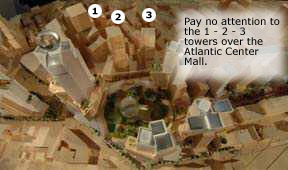 However, there’s no provision in the report for the three towers Forest City Ratner plans over the Atlantic Center mall north of Atlantic Avenue, which, according to the FEIS, would be built by 2013. They would surely compound the effect.
However, there’s no provision in the report for the three towers Forest City Ratner plans over the Atlantic Center mall north of Atlantic Avenue, which, according to the FEIS, would be built by 2013. They would surely compound the effect.
Clues in the comments
After the Draft Environmental Impact Statement was issued in July, the ESDC received some 20 comments about the potential impacts of wind, for example:
The height of the proposed buildings will create a tunnel or canyon effect, resulting in a darker and windier environment.
Representatives of the Brooklyn Bear’s Garden expressed concern about damage to street trees, dust, and significantly dryer conditions.
ESDC response
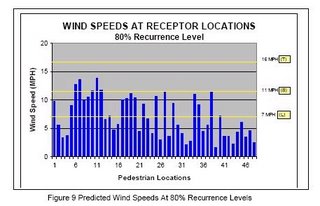 The ESDC responded:
The ESDC responded:
In response to comments, an evaluation of wind conditions was conducted, and indicated that although some increase in wind speed at pedestrian levels would be expected, the proposed project would not result in adverse wind conditions in or around the project site. At the Brooklyn Bear’s Community Garden, the wind conditions would be suitable for the type of activity expected in such a space, i.e., sitting, standing, gardening, and leisurely walking. In the area of the garden as a whole, the evaporative capability of the winds above the vegetation would increase somewhat, but since plants draw the needed amount of water from the surrounding soil, and the soil, when irrigated, usually contains more water than actually used by the plants, additional irrigation may not be necessary. In any case, for a small garden, this small increase would not represent a significant amount of water.
(Above right, the expected wind speeds, mapped by receptor location.)
Uncomfortable winds?
Would it ever get really uncomfortable? No, according to the report:
No locations were found to be in the uncomfortable range, greater than 20 mph, more than 1% of the time - well within the normal occurrence level for the area.
However, that does raise some questions. Do those very infrequent uncomfortable winds get particularly worse due to taller buildings? In other words, would infrequent 25 mph or 30 mph winds get 20 percent faster—or more—because of this project?
Still, the report doesn’t try to pin down whether uncomfortable winds would be more likely in the winter, when they’d exacerbate wind chill:
Due to limited historical data on directional probability of approaching wind on a seasonal basis, no conclusions can be drawn on seasonal variability of wind speed.
Would the Atlantic/Flatbush corner become occasionally dangerous? No. According to the report, wind speeds greater than 45 mph would be expected less than .001 percent of the time, or less than 5 minutes a year.
One gardening day lost weekly?
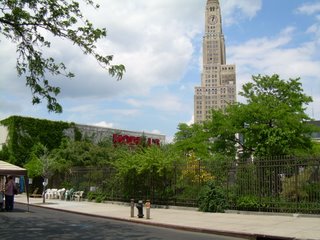 The Bear’s garden, which would abut the tower at Site 5 at the southeast corner of Atlantic, Flatbush, and Fourth avenues, and would sit opposite Miss Brooklyn, would bear the brunt of the wind, compared to other parks and open space locations.
The Bear’s garden, which would abut the tower at Site 5 at the southeast corner of Atlantic, Flatbush, and Fourth avenues, and would sit opposite Miss Brooklyn, would bear the brunt of the wind, compared to other parks and open space locations.
The report states:
Locations that may have more extended use, such as parks and open space, would experience suitable conditions (<11 MPH) at least 91% of the time, with the exception of the Brooklyn Bears Community Garden where such conditions would be expected at least 86% of the time.
Thus, for 14 percent of the time, roughly one day a week, the garden would not be “suitable for sitting, walking, and general gardening activities.” Still, the increase in wind “is not considered significant.”
Wind criteria
Below are the criteria used by Newmerical:
Leisure Sitting, Dining (L): Wind speeds below 7 MPH would be acceptable for leisure sitting for extended periods of time and is suitable for outdoor dining.
Sitting (S): Wind speeds 0 - 11 MPH. This range of wind speeds is suitable for short term sitting at outdoor cafes, standing, or strolling. These are light to gentle breezes where wind is felt on face, leaves rustle, small branches and twigs are in constant motion.
Standing (T): Wind speeds 0 - 16 MPH. This range of wind speeds is suitable at building entrances, bus stops, short term sitting, window shopping, and leisurely walking. These are moderate breezes where, at the higher end of this range, dust, loose paper and small branches are in motion.
Walking (W): Wind speeds 0 - 20 MPH. This range of wind speeds is suitable for brisk walking, parks, and general pedestrian activities. At the higher end of this range, small leafed trees begin to sway, crested wavelets form on inland waterways, and umbrella usage becomes difficult.
Uncomfortable (U): Wind speeds > 20 MPH. These winds are generally considered uncomfortable and begin to become a nuisance for most activities.
Dangerous (D): Wind speeds > 45 MPH. At these speeds, whole trees are in motion, walking is difficult, and performance of general activities is impeded.
 The Urban Room proposed for the corner of Flatbush and Atlantic avenues would serve as the entrance to the Brooklyn Arena and Frank Gehry’s flagship skyscraper Miss Brooklyn. Graphics (right) from landscape architect Laurie Olin show people sitting on the steps and at tables outside.
The Urban Room proposed for the corner of Flatbush and Atlantic avenues would serve as the entrance to the Brooklyn Arena and Frank Gehry’s flagship skyscraper Miss Brooklyn. Graphics (right) from landscape architect Laurie Olin show people sitting on the steps and at tables outside.(That table in the foreground would be right near a supremely busy intersection.)
Gehry calls it the “front stoop,” a place for kids to "hang out," according to a 5/13/06 Brooklyn Papers article headlined MEET MISS BROOKLYN.
But a newly released “pedestrian wind impact study,” cited in the Atlantic Yards Final Environmental Impact Statement (FEIS), suggests that the area around the Urban Room wouldn’t be suitable for leisure sitting/dining and even some short-term sitting. That suggests that Olin’s illustration is rather fanciful.
(The report is not attached to the FEIS; I asked the Empire State Development Corporation about it, and was forwarded a copy: 2MB PDF and embedded below.)
No significant hardship
 The conclusion to the 22-page report, conducted by Minneapolis-based Newmerical Technologies International for AKRF, the consultancy that conducted most of the environmental impact analysis, is benign:
The conclusion to the 22-page report, conducted by Minneapolis-based Newmerical Technologies International for AKRF, the consultancy that conducted most of the environmental impact analysis, is benign:In general, while ground-level wind speeds in the area are projected to increase with the addition of the proposed Atlantic Yards Arena project for all locations identified, these increases would not cause significant hardship to pedestrians.
However, data for some specific locations does raise concerns, notably for the uses projected outside the Urban Room. Surveying the location described as “Flatbush Avenue, Arena,” the report states:
All receptor locations indicate wind speeds less than 16 MPH for an 80% recurrence level. These wind levels indicate comfort conditions suitable for walking and general activities.
But not sitting, as in the illustration.
 Emerging standards
Emerging standardsNew York City, the study acknowledges, does not have wind-related pedestrian comfort criteria, so Newmerical uses general design guidelines used throughout the U.S. and Canada, which define wind speeds determined to be comfortable for different expected uses at least 80% of the time.
In other words, if the wind speeds are not comfortable 80 percent of the time, they’re unacceptable.
At 14 of 48 locations tested (or 29 percent), the results were unacceptable for the two sets of activities most affected by wind. (Those locations are marked in red in the chart at right adapted from Newmerical’s report. Click to enlarge.)
 Only wind speeds below 7 MPH are be acceptable for extended leisure sitting or outdoor dining. Only wind speeds below 11 MPH are suitable for “short-term sitting at outdoor cafes, standing, or strolling.” The latter are “light to gentle breezes.”
Only wind speeds below 7 MPH are be acceptable for extended leisure sitting or outdoor dining. Only wind speeds below 11 MPH are suitable for “short-term sitting at outdoor cafes, standing, or strolling.” The latter are “light to gentle breezes.”Notably, at receptors 6 and 7, at the corner of Atlantic and Flatbush, the results were well below the 80 percent goal.
For receptor 6, the wind would be acceptable for leisure sitting 46 percent of the time; for receptor 7, it would be 39 percent of the time. As for general sitting, the numbers are 67 percent and 64 percent respectively.
However, the report aggregates some numbers and thus obscures the impact on the Urban Room:
With the exception of several locations near the intersection of Flatbush and Atlantic Avenues and a few narrow passages between the proposed buildings, all locations had predicted wind speeds suitable for short term sitting, leisurely walking, and waiting, such as bus stops (<16 mph) ranging from 92% to 100% of the time; near the intersection of Flatbush and Atlantic Avenues and within some narrow passages mentioned above such conditions would be expected at least 84% of the time.
Setting out the problem
 Everyone knows that tall buildings can exacerbate wind. The Williamsburgh Savings Bank tower just northwest of the proposed Atlantic Yards site is a prime example.
Everyone knows that tall buildings can exacerbate wind. The Williamsburgh Savings Bank tower just northwest of the proposed Atlantic Yards site is a prime example.The report acknowledges:
Large buildings can impact wind speed and turbulence by diverting stronger winds from aloft down to street-level (downwash) and by restricting wind flow between buildings (canyon effect, or channeling).
…The highest probabilities of approaching winds and wind speeds occur in the northern, western, and southern quadrants. As these directions are somewhat aligned with the avenues, there is some credence to the concerns of potentially high groundlevel winds in the canyons formed by adjacent buildings.
(Above right, red arrows and highlighted circles indicate where wind speed would increase.)
A solution unmentioned
Danish urban planner Jan Gehl, who visited Brooklyn last year, suggested a solution to the wind problem: a mix of building sizes. As reported by Ezra Goldstein in the Park Slope Civic Council’s Civic News:
On the walk, Gehl talked about how, at street level, a solid wall of high rise buildings blocks the sun and creates a wind tunnel effect. He told his listeners how Vancouver, British Columbia, has surrounded skyscrapers with lower buildings that let in light and deflect down-currents of air from the towers.
Atlantic Center effect?
In Brooklyn, however, the problem may only get worse. The report acknowledges:
There are several taller buildings north of Atlantic Avenue abutting Flatbush Avenue that also provide blockage and contribute to the canyon effect for winds from the NW, North, and West.
 However, there’s no provision in the report for the three towers Forest City Ratner plans over the Atlantic Center mall north of Atlantic Avenue, which, according to the FEIS, would be built by 2013. They would surely compound the effect.
However, there’s no provision in the report for the three towers Forest City Ratner plans over the Atlantic Center mall north of Atlantic Avenue, which, according to the FEIS, would be built by 2013. They would surely compound the effect.Clues in the comments
After the Draft Environmental Impact Statement was issued in July, the ESDC received some 20 comments about the potential impacts of wind, for example:
The height of the proposed buildings will create a tunnel or canyon effect, resulting in a darker and windier environment.
Representatives of the Brooklyn Bear’s Garden expressed concern about damage to street trees, dust, and significantly dryer conditions.
ESDC response
 The ESDC responded:
The ESDC responded:In response to comments, an evaluation of wind conditions was conducted, and indicated that although some increase in wind speed at pedestrian levels would be expected, the proposed project would not result in adverse wind conditions in or around the project site. At the Brooklyn Bear’s Community Garden, the wind conditions would be suitable for the type of activity expected in such a space, i.e., sitting, standing, gardening, and leisurely walking. In the area of the garden as a whole, the evaporative capability of the winds above the vegetation would increase somewhat, but since plants draw the needed amount of water from the surrounding soil, and the soil, when irrigated, usually contains more water than actually used by the plants, additional irrigation may not be necessary. In any case, for a small garden, this small increase would not represent a significant amount of water.
(Above right, the expected wind speeds, mapped by receptor location.)
Uncomfortable winds?
Would it ever get really uncomfortable? No, according to the report:
No locations were found to be in the uncomfortable range, greater than 20 mph, more than 1% of the time - well within the normal occurrence level for the area.
However, that does raise some questions. Do those very infrequent uncomfortable winds get particularly worse due to taller buildings? In other words, would infrequent 25 mph or 30 mph winds get 20 percent faster—or more—because of this project?
Still, the report doesn’t try to pin down whether uncomfortable winds would be more likely in the winter, when they’d exacerbate wind chill:
Due to limited historical data on directional probability of approaching wind on a seasonal basis, no conclusions can be drawn on seasonal variability of wind speed.
Would the Atlantic/Flatbush corner become occasionally dangerous? No. According to the report, wind speeds greater than 45 mph would be expected less than .001 percent of the time, or less than 5 minutes a year.
One gardening day lost weekly?
 The Bear’s garden, which would abut the tower at Site 5 at the southeast corner of Atlantic, Flatbush, and Fourth avenues, and would sit opposite Miss Brooklyn, would bear the brunt of the wind, compared to other parks and open space locations.
The Bear’s garden, which would abut the tower at Site 5 at the southeast corner of Atlantic, Flatbush, and Fourth avenues, and would sit opposite Miss Brooklyn, would bear the brunt of the wind, compared to other parks and open space locations. The report states:
Locations that may have more extended use, such as parks and open space, would experience suitable conditions (<11 MPH) at least 91% of the time, with the exception of the Brooklyn Bears Community Garden where such conditions would be expected at least 86% of the time.
Thus, for 14 percent of the time, roughly one day a week, the garden would not be “suitable for sitting, walking, and general gardening activities.” Still, the increase in wind “is not considered significant.”
Wind criteria
Below are the criteria used by Newmerical:
Leisure Sitting, Dining (L): Wind speeds below 7 MPH would be acceptable for leisure sitting for extended periods of time and is suitable for outdoor dining.
Sitting (S): Wind speeds 0 - 11 MPH. This range of wind speeds is suitable for short term sitting at outdoor cafes, standing, or strolling. These are light to gentle breezes where wind is felt on face, leaves rustle, small branches and twigs are in constant motion.
Standing (T): Wind speeds 0 - 16 MPH. This range of wind speeds is suitable at building entrances, bus stops, short term sitting, window shopping, and leisurely walking. These are moderate breezes where, at the higher end of this range, dust, loose paper and small branches are in motion.
Walking (W): Wind speeds 0 - 20 MPH. This range of wind speeds is suitable for brisk walking, parks, and general pedestrian activities. At the higher end of this range, small leafed trees begin to sway, crested wavelets form on inland waterways, and umbrella usage becomes difficult.
Uncomfortable (U): Wind speeds > 20 MPH. These winds are generally considered uncomfortable and begin to become a nuisance for most activities.
Dangerous (D): Wind speeds > 45 MPH. At these speeds, whole trees are in motion, walking is difficult, and performance of general activities is impeded.
Comments
Post a Comment